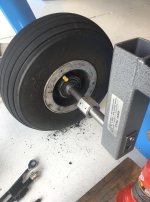Kyle Boatright
Well Known Member
Every time I pull the wheels on one of the airplanes I dread putting the cotter back in the wheel nut. It generally takes a ridiculous amount of time (x2), and leaves me wondering why I don't see others complaining about it.
What I do is mark the wheel and nut to properly index the nut so the holes are aligned. Then I use a something (ex: the old cotter) to verify that the holes are properly aligned. I sharpen the new cotter so it self-aligns a little more easily as it passes through the hole on the back side of the axle.
And it takes forever. Or several minutes a side.
How do I make this process go faster?
What I do is mark the wheel and nut to properly index the nut so the holes are aligned. Then I use a something (ex: the old cotter) to verify that the holes are properly aligned. I sharpen the new cotter so it self-aligns a little more easily as it passes through the hole on the back side of the axle.
And it takes forever. Or several minutes a side.
How do I make this process go faster?






